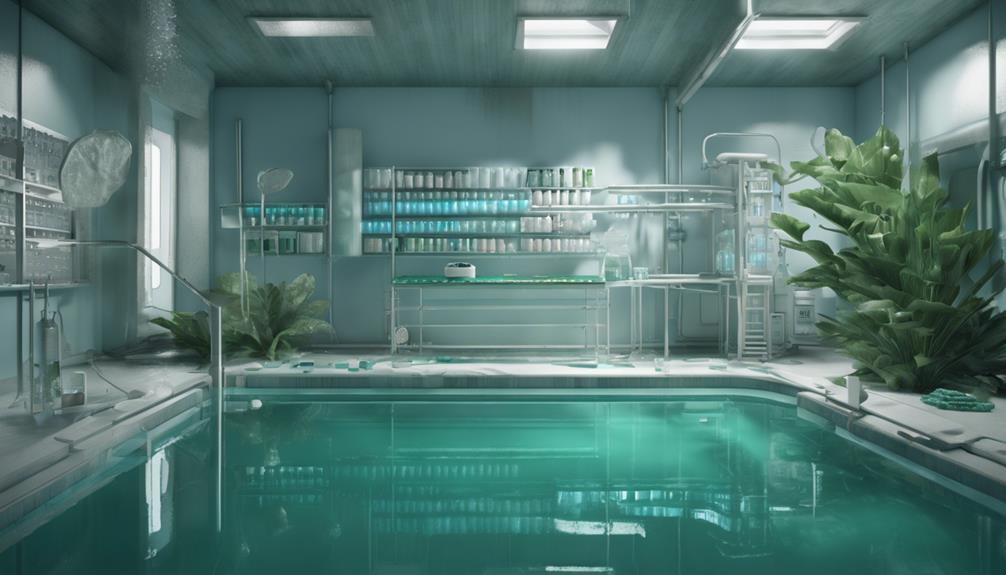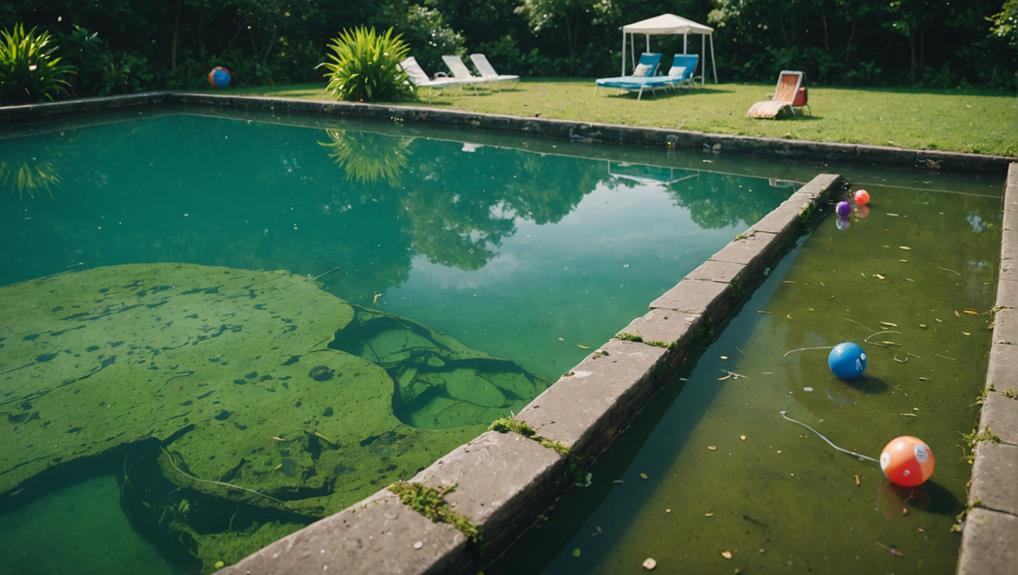You're racing against the clock to rescue your green pool! To get it back in shape, focus on three key areas: shock treatment, thorough cleaning, and chemistry balancing. Start by shocking your pool with 5-10 gallons of chlorine to break down algae, then let it settle for 14-24 hours. Next, brush and vacuum the entire pool surface to remove dirt and debris. Finally, balance your pool's chemistry by testing and adjusting alkalinity, pH, calcium hardness, and chlorine levels. By tackling these three areas, you'll be well on your way to a safe and sparkling clean pool – and there's more to learn about refining this process.
Key Takeaways
- Shock the pool with 5-10 gallons of chlorine to break down algae and prepare for further cleaning.
- Let the algae die and settle to the floor for 14-24 hours after shocking to ensure complete eradication.
- Brush and vacuum the entire pool surface, stairs, walls, and corners to physically remove dirt and debris.
- Balance pool chemistry by testing and adjusting alkalinity, pH, calcium hardness, and chlorine levels to create a safe swimming environment.
- Regularly test the water to maintain proper chlorine levels and confirm a healthy swimming environment.
Shock and Filter the Pool
When tackling a green pool, you must start by shocking it with a large dose of chlorine to kill the algae and initiate the cleaning process.
The amount of chlorine needed depends on the pool size and algae thickness, typically ranging from 5-10 gallons.
This initial shock treatment is pivotal to break down the algae and prepare the pool for further cleaning.
After shocking, turn off the pump and let the algae die and settle to the floor for 14-24 hours.
This waiting period is essential to verify the algae is fully eradicated.
Once the waiting period is complete, turn on the filter and allow it to run continuously to maintain clean and clear water.
Monitoring filter pressure is vital to guarantee peak performance.
Remember, filtering the pool water is pivotal to remove remaining dirt and debris, especially during the cleaning process.
Brush and Vacuum Thoroughly
With your pool now filtered and algae-killed, it's time to physically remove the remaining dirt and debris by brushing and vacuuming the entire pool surface, stairs, walls, and corners.
You'll need to brush the entire pool to loosen accumulated algae and debris, using a heavy-duty brush for concrete pools and a soft-bristled brush for vinyl or fiberglass pools.
Next, vacuum the pool thoroughly, making several passes if necessary, to remove dirt, debris, and dead algae. Use a vacuum head with bristles, cutting them in 1-inch increments to prevent getting stuck to the pool bottom.
If the pool is too dirty to vacuum, use a leaf rake to remove debris and let the pool settle before re-raking. You may need to repeat the brushing and vacuuming process several times until the pool is clear of debris and algae.
Consider using a side vac (pump) to vacuum the pool to waste, especially with mesh pool covers, and connect a hose directly to the front of the pump to avoid clogging or damaging the plumbing.
Balance Pool Chemistry Fast

You'll need to test and adjust your pool's chemical levels to guarantee a safe and healthy swimming environment, starting with alkalinity, which should be maintained between 100-150 ppm to stabilize pH levels and prevent sudden changes. To keep your pool clean and free of algae and bacteria, you'll need to balance your pool chemistry fast.
| Chemical Level | Target Range | Importance |
|---|---|---|
| Alkalinity | 100-150 ppm | Stabilize pH levels, prevent sudden changes |
| pH | 7.4-7.6 | Certify chlorine is effective in killing algae and bacteria |
| Calcium Hardness | 200-400 ppm | Prevent corrosion, scaling, and cloudy water |
| Stabilizer (CYA) | 30-50 ppm | Prevent chlorine degradation from sunlight |
Shocking the pool and running the pool filter will help circulate the adjusted chemicals and keep your pool clean. Remember to test the water regularly to maintain proper chlorine levels (at least 2 ppm) and confirm a safe and healthy swimming environment. By following these guidelines, you'll be able to clean a green pool quickly and efficiently, and maintain proper pool care.
Frequently Asked Questions
How to Clear a Green Pool Quickly?
'Coincidentally, you're not alone in dealing with a green pool! To clear it quickly, you'll need to shock it with a fast treatment, balance the chemicals, and guarantee proper filtration, skimmer maintenance, and circulation – all while brushing and testing the water regularly.'
What Kills Pool Algae the Fastest?
You'll find that shocking with high chlorine levels or using copper-free algaecide products are the fastest ways to kill pool algae, while ozone generators, UV light technology, and enzyme-based cleaners provide effective prevention methods.
How to Clear up a Pool Fast?
When murky waters turn your backyard oasis into a swampy nightmare, you need an urgent solution. You can achieve fast results with DIY methods like shock treatment, pool testing, and emergency cleaning, prioritizing pool maintenance to guarantee water clarity and swimming safety.
Can You Clean a Green Pool Without Draining It?
You can clean a green pool without draining it, debunking the myth that partial draining is necessary; however, it requires understanding algae tolerance, shock treatment, and proper pool circulation, filter cleaning, and chlorine levels, which all start with accurate water testing and regular maintenance to address underlying green pool causes.
Conclusion
By shock treating and filtering, brushing and vacuuming, and balancing your pool chemistry, you'll be swimming in a crystal-clear oasis in no time.
Don't worry if you're not a pool expert – just follow these simple steps and you'll be enjoying your backyard paradise in no time.
And to put your mind at ease, think of it like this: a green pool is like a dirty room – clear the clutter, wipe down the surfaces, and voila! A fresh new space!

I’m Max, the founder and chief pool enthusiast behind Pool Pro Tips. As a passionate pool owner and cleaning expert, I created this website to share my knowledge and experience with you, helping you to keep your pool sparkling clean and safe for years to come.

